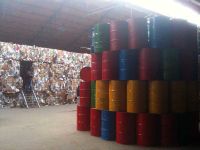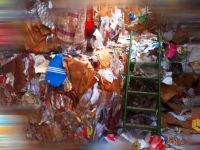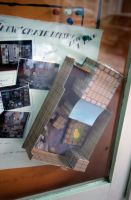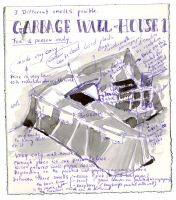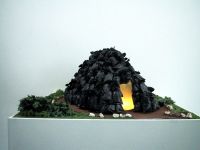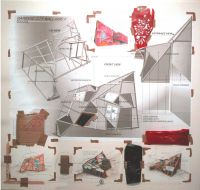29.05.2010 - 31.10.2010
opening: 29.05.2010, 18.00
curator: Geert Verbeke
From 29.05.2010 until 31.10.2010 organizes the Verbeke Foundation an exhibition about green energy.
PHOTOS OF THE SMELL - INSTALLATION GARBAGE CITY - HOLIDAY PARK
Overview
Paper House
Barrel House
Black Garbage Iglo
Everyone who has ever smelt Peter De Cupere‘s work cannot fail to recognise that his works prompt quite a reaction. You either love it or you feel attacked via your nasal senses. If the latter is true it is often because the spectator adopts a reserved attitude at fi rst as a result of being wary of the unknown. That is exactly why smells in art have been and are still positively avoided. People like to compare and want a return or recognition. This is diffi cult with smells because they act directly on the limbic system and don‘t give you the necessary time and chance to translate things like you do with „sight“. Smells act on your memory subconsciously and so you associate your own subjective feelings with a specifi c smell. Your attitude to the object is determined by the smell memory of a certain moment. Add then the combination with the visual aspect of the artwork and you get a mix that does not appear to be completely predictable. Alongside the pleasance of some smells there are also smells that warn us of danger though we do not always heed these indications because of habituation. If you cross the street there are many damaging smells present because of pollution: exhaust fumes, rotting processes from discarded foodstuffs, toxic fumes from asphalt and other building materials that are freed by heat from the sun, polluted rain, sewers, etc. But the normal city person has become used to all the exhaust fumes and other air-polluting substances.

In „Garbage City Holiday Park“ Peter De Cupere makes a number of reflections on the pollution of society and its effect on our environment. They are not critical arguments, but more poetic reflections on the phenomenon of
pollution. A deep respect for the environment and so primarily for smells of nature is interspersed throughout the whole work. Even though the smell substances are made by the artist in a way identical to nature, the question remains as to how much you as a visitor experience a certain smell as natural. Through the absence of natural references within the four walls of the exhibition space you are easily influenced by preconceptions. „Garbage City“ is a mock mini-city made from waste materials where you as a visitor can stay just like in a holiday park. The concept is simple: You rent a „Garbage House“ for a certain period and stay there. Furthermore during this period you make other Garbage-Houses together with your co-inhabitants, which can then be let to other people. In this way „Garbage City“ grows in to a larger community. It is a way of spending your holiday in a creative way and also of becoming more conscious of the waste mountain and its effects on society. Each Garbage-House gets its own added smell, so that direct references to certain products disappear. This smell is lightly present in the set up rubbish house, in order to act on the state of mind. In the exhibition you can find out for yourself what such a Garbage-House would look like.
 Peter De Cupere has made a Black Garbage Iglo for us in which you can experience a pleasant smell. (See model, images of the real installation will follow measures 7,5 m W x 9,5 m L x 4,5 m H ) Furthermore you can experience the whole concept in models, technical diagrams and a visual representation of such a Garbage City Holiday Park. The seriousness with which the artist has worked out this concept gives the project a high level of credibility.
Peter De Cupere has made a Black Garbage Iglo for us in which you can experience a pleasant smell. (See model, images of the real installation will follow measures 7,5 m W x 9,5 m L x 4,5 m H ) Furthermore you can experience the whole concept in models, technical diagrams and a visual representation of such a Garbage City Holiday Park. The seriousness with which the artist has worked out this concept gives the project a high level of credibility.
In 2002 Peter De Cupere showed us a Garbage House in a group exhibition in the Antwerp courthouse. In this miserable Garbage house, made from crates and waste material, people got an unexpectedly pleasant experience of smell from the 120 kg of pure mint leaves on the ground. In 2004 he showed his Garbage Wall House in the Tim Van Laere Gallery in Antwerp.
 The disappearance of plant and animal species, the rise of water levels, massive deforestation, the ecological footprint, the Tokyo protocol, the Copenhagen climate summit... it is a long list to enumerate. The Earth is in danger, that much is certain: it is a daily reoccuring subject in various media! With its 12 hectares of scenic area and its 20,000 square metres of covered space, the Verbeke Foundation is one of Europe's largest private initiatives where culture, nature and ecology meet together. This, in its entirety, is the concrete occasion to the Verbeke Foundation to dedicate its next summer exhibition to ecology.
The disappearance of plant and animal species, the rise of water levels, massive deforestation, the ecological footprint, the Tokyo protocol, the Copenhagen climate summit... it is a long list to enumerate. The Earth is in danger, that much is certain: it is a daily reoccuring subject in various media! With its 12 hectares of scenic area and its 20,000 square metres of covered space, the Verbeke Foundation is one of Europe's largest private initiatives where culture, nature and ecology meet together. This, in its entirety, is the concrete occasion to the Verbeke Foundation to dedicate its next summer exhibition to ecology.
The exhibition will give a complete overview of the works artists realised, from the 1960's right up until today, proceeding from their confrontation with environmental pollution. The cultural dimensions of climate change and also the capacity of man to find solutions for survival will so be shed light on. The customary discourse in which the artist is seen as a creator of images for use of reflection, discussion and awakening, will be questioned by also exhibiting the works of architects and designers. After all, their creations provide us with concrete solutions for the improvement of human behaviour.
The first part of the exhibition will be devoted to artist projects on human pollution of natural space. Performances of Mass Moving, which are decades old, will be on display to emphasize the early commitment of artists to the ecological debate. Adjoining it, works composed of recycled waste materials, will be shown to broach mass production and use of these materials in our contemporary society.
Parallel to this, works driven by forms of renewable energy, will be displayed: some artists utilize wind or solar energy for their installations. For the development of these systems the artists strive to limit costs and pollution. The stress of this second part of the exhibition layed on ecological projects of generation DIY (do It Yourself) designers.
Ecological architectural projects complete the exhibition. New construction procedures, as well as methods to deal with warmth and materials economically for the design of buildings, are dealt with.
More info: www.verbekefoundation.com
| < Prev | Next > |
|---|



